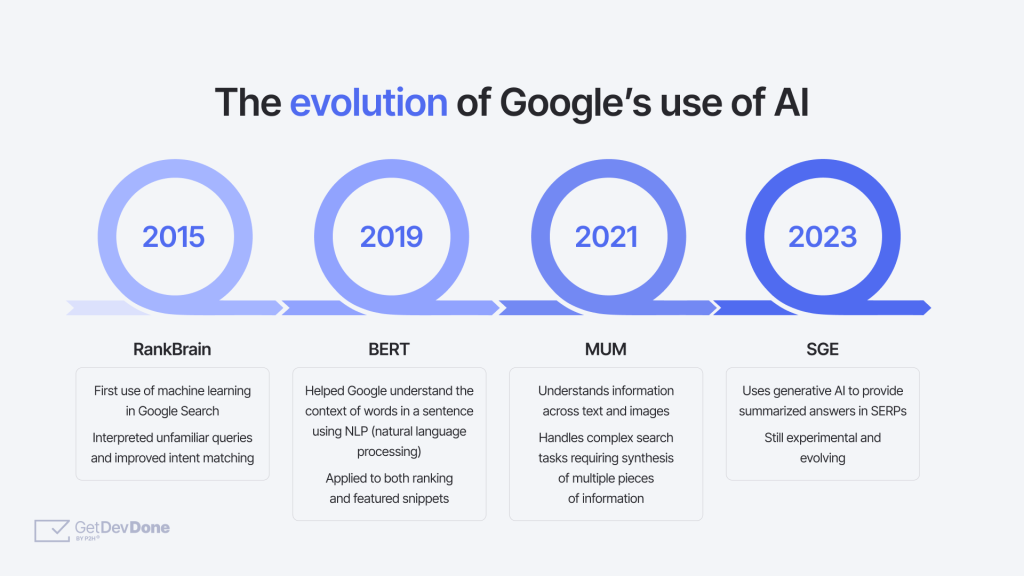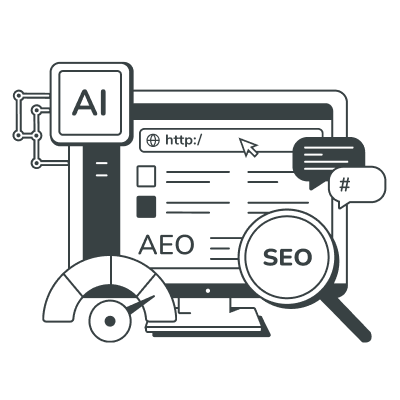SEO is dead.
I’ve lost count of how many times I’ve heard that.
Every time Google rolls out a major update, whether it’s mobile-first indexing or Core Web Vitals, someone declares the death of SEO. But somehow, SEO always survives. It just evolves.
And businesses must evolve with it.
In this article, I break down what AI and the future of SEO really look like when you strip away the hype.
SEO Met AI Long Before ChatGPT
Let’s clear something up right away: AI isn’t new to search.
The industry just started paying more attention when ChatGPT arrived and made AI feel real for everyone else.
But Google has been using AI in search since at least 2015. That’s when they launched RankBrain, their first machine learning system. Its job was to understand search queries better, especially the ones Google had never seen before. It helped the algorithm figure out what people meant, not just what they typed.
Sound familiar?
Back then, many SEOs panicked. People said, “Keywords are dead!”
But SEO didn’t die. It adapted.
Then came BERT, which helped Google understand the context of words.
After that, MUM, which could process text, images, and even video in multiple languages.
And now, we are talking about SGE (Search Generative Experience).

It’s a long evolution that shows the deep connection between AI and the future of SEO. Each new update reshapes how we optimize content. But the goal stays the same: helping people find what they need.
And that’s why SEO keeps going. Because the fundamentals still matter – AI or not.
Two Faces of AI in Search
AI is changing search, but not in just one way. It’s happening in two directions at once.
1. AI Inside Google (SGE)
Google is building AI right into the search engine. You might have seen this already: AI-generated answers at the top of the results page. That is a part of SGE.
Instead of a list of blue links, users now get a quick summary. Google pulls info from multiple sources and gives you the answer up front.
Sounds helpful, right?
It is for users.
But for website owners, it can mean less visibility and less traffic. Especially if your content focuses on answering basic informational questions. If Google’s AI gives the answer without a click, your blog post might never get seen.
This is a big shift. We are moving from search as a directory to search as a direct answer machine.
Still, not all content types are at risk. In-depth guides, product comparisons, opinion pieces still draw traffic. Especially if they offer something AI cannot fake: experience, authority, and trust.
2. AI Outside Google (ChatGPT, Perplexity, Claude)
AI doesn’t just change search engines. It creates new ones. ChatGPT, Claude, and Perplexity aren’t built to link you to websites. They are built to give you answers directly.
People mainly use them for summaries. They are not looking for ten links, they want a clear takeaway.
This change in user intent influences traffic acquisition. It’s no longer just about rankings, it’s about being the source AI trusts enough to quote.
What does this mean for SEO?
You must optimize for AEO (Answer Engine Optimization).
That means making sure the content is clear, structured, and answer-friendly. Because if AI pulls from the web to generate responses, you want your site to be the one it learns from.
SEO vs AEO: What’s Different, What Overlaps
| Traditional SEO | AEO | Both | |
| Goal | Rank higher in search results | Be the trusted source for AI answers | Deliver useful content |
| Content Format | In-depth articles, keyword-rich pages | Clear, answer-focused blocks | High-quality, structured content |
| Keyword Strategy | Optimized for specific queries | Optimized for question-based prompts | Natural language, long-tail keywords |
| SERP Visibility | Aims for blue link clicks | Aims for AI summary inclusion | Seeks to increase visibility and traffic |
| Markup and Schema | Helpful, but not always used | Essential for clarity and AI understanding | FAQ, How-To, and article schema |
| Citations and Mentions | Boosts trust and authority | Helps AI models “trust” your content | Build E-E-A-T – Experience, Expertise, Authority, Trust |
| Technical SEO | Focus on speed, crawlability, indexation | Still necessary, but less directly visible | Foundational for both |
| Content Updates | Important for rankings | Crucial for AI relevance | Freshness improves performance |
| Traffic Source | Organic clicks from search results | Indirect exposure via AI-generated answers | Both contribute to discoverability |
| Main Risk | Algorithm updates | AI models omitting attribution or links | Needs ongoing adaptation |
What Still Works, And Works Even Better Now
Here’s the good news: most of what has worked in SEO still works today. In fact, it may work even better in an AI-first world.
Why? Because AI is trained to look for clear, useful, well-structured content. And that’s exactly what SEO has always aimed for.
Here is what to keep focusing on:
- Clear structure. Use headings, subheadings, and lists. AI and humans love scannable content.
- Direct answers. Include short, focused answers to specific questions. Great for featured snippets and AI summaries.
- Natural language. Write like a human. Use long-tail keywords and phrases your audience types.
- Schema markup. Mark up your FAQs, How-Tos, and articles. This helps machines understand your content better.
- Fast, crawlable sites. Technical SEO still matters. If Google can’t crawl your site, it won’t rank it and won’t learn from it.
- Cover related questions. Anticipate follow-ups. AI tools often pull from Q&A-style content.
- Update regularly. AI models prefer fresh, up-to-date info. Keep your top pages current.
- Build authority. Brand mentions, expert authorship, and trust signals all count. Maybe more than ever.
In short: if you’ve been doing SEO the right way, you are already on the path to effective AEO.
Closing Thoughts: SEO Isn’t Dead, It’s Just Smarter Now
So, is SEO dead?
Not even close.
It’s changing. Yes. But it always has.
AI is the latest shift. It’s big, but it doesn’t change the core goal: help people find useful, trustworthy content.
What is different now is how people search and how machines surface answers. That means we need to think about both SEO and AEO. We are not just ranking for keywords anymore. We are also training the systems that serve answers.
So, if your content is clear, helpful, structured, and real, you’ll show up both in a search result and AI summary.
After all, it’s about being genuinely useful to both people and machines.

